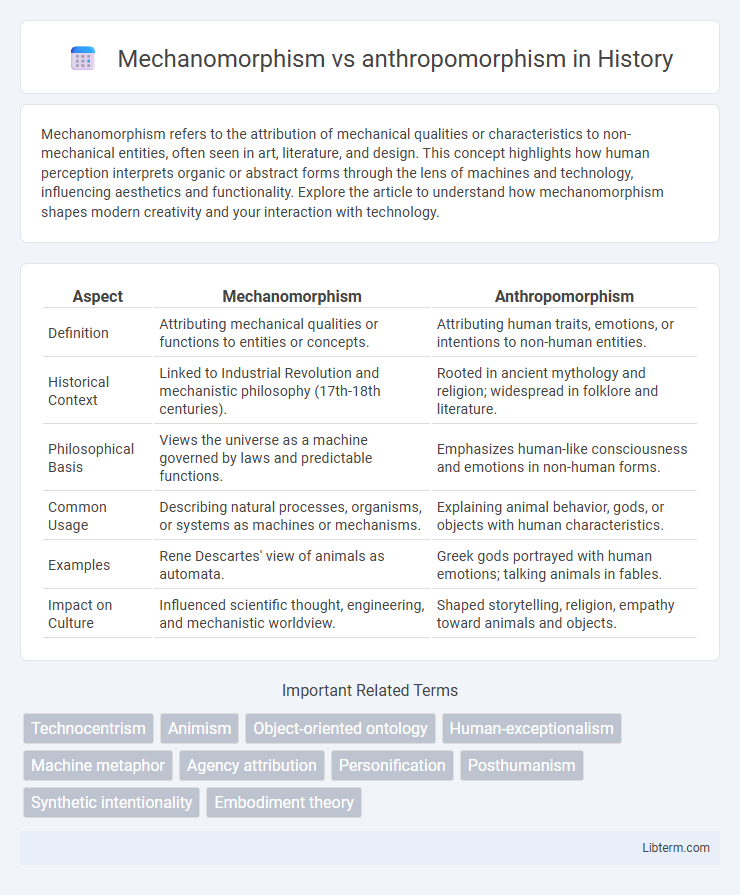Mechanomorphism refers to the attribution of mechanical qualities or characteristics to non-mechanical entities, often seen in art, literature, and design. This concept highlights how human perception interprets organic or abstract forms through the lens of machines and technology, influencing aesthetics and functionality. Explore the article to understand how mechanomorphism shapes modern creativity and your interaction with technology.
Table of Comparison
| Aspect | Mechanomorphism | Anthropomorphism |
|---|---|---|
| Definition | Attributing mechanical qualities or functions to entities or concepts. | Attributing human traits, emotions, or intentions to non-human entities. |
| Historical Context | Linked to Industrial Revolution and mechanistic philosophy (17th-18th centuries). | Rooted in ancient mythology and religion; widespread in folklore and literature. |
| Philosophical Basis | Views the universe as a machine governed by laws and predictable functions. | Emphasizes human-like consciousness and emotions in non-human forms. |
| Common Usage | Describing natural processes, organisms, or systems as machines or mechanisms. | Explaining animal behavior, gods, or objects with human characteristics. |
| Examples | Rene Descartes' view of animals as automata. | Greek gods portrayed with human emotions; talking animals in fables. |
| Impact on Culture | Influenced scientific thought, engineering, and mechanistic worldview. | Shaped storytelling, religion, empathy toward animals and objects. |
Introduction to Mechanomorphism and Anthropomorphism
Mechanomorphism refers to attributing mechanical characteristics or functions to living beings, often depicting animals or humans with machine-like parts or robotic features. Anthropomorphism involves assigning human traits, emotions, or intentions to non-human entities, such as animals, gods, or objects, to facilitate understanding or emotional connection. These concepts explore how humans interpret and represent non-human subjects through different lenses of mechanical or human-like qualities.
Defining Mechanomorphism: Viewing Life as Machine
Mechanomorphism defines life through the lens of mechanical principles, interpreting biological processes as functions of machines or technology. This perspective emphasizes predictability, structure, and efficiency in understanding living organisms, treating them as complex systems composed of interacting parts. Contrasting with anthropomorphism, mechanomorphism reduces life to mechanical interactions rather than attributing human traits or emotions.
Understanding Anthropomorphism: Attributing Human Traits
Understanding anthropomorphism involves attributing human traits, emotions, and intentions to non-human entities such as animals, objects, or natural phenomena. This psychological tendency aids in making sense of the world by projecting familiar human characteristics onto unfamiliar entities, which can enhance empathy and communication in human-computer interaction, robotics, and storytelling. Unlike mechanomorphism, which ascribes machine-like qualities, anthropomorphism emphasizes human-like attributes, highlighting the importance of cognitive bias in perception and interpretation.
Historical Origins of Both Concepts
Mechanomorphism traces its origins to the Enlightenment era, where the mechanistic view of nature was popularized by philosophers like Rene Descartes, who likened living organisms to complex machines governed by physical laws. Anthropomorphism, however, dates back to ancient civilizations such as Mesopotamia and Egypt, where gods and natural forces were attributed human traits to explain and relate to the environment. Both concepts reveal historical human attempts to interpret the unknown by projecting familiar frameworks, mechanical or human, onto natural phenomena.
Mechanomorphism in Science and Technology
Mechanomorphism in science and technology refers to attributing mechanical properties or functions to biological systems, enabling the design of biomimetic robots, prosthetics, and artificial organs. This approach facilitates the integration of engineering principles with biological inspiration, improving efficiency in automation, bioengineering, and nanotechnology. Mechanomorphism emphasizes mechanical analogies over human traits, optimizing innovation through precise modeling of physical processes and structures.
Anthropomorphism in Culture and Art
Anthropomorphism in culture and art involves attributing human traits, emotions, or intentions to non-human entities like animals, objects, or deities, often serving to forge emotional connections and convey complex ideas more accessibly. Iconic examples include ancient Egyptian gods such as Anubis with a jackal head, medieval allegorical figures, and contemporary animated characters like Disney's Mickey Mouse, all reflecting societies' efforts to humanize the abstract or unfamiliar. This practice reveals cultural values and psychological insights, highlighting humans' tendency to interpret the world through a human-centered perspective, deeply influencing literature, visual arts, and religious symbolism.
Impacts on Human Perception and Cognition
Mechanomorphism and anthropomorphism shape human perception and cognition by influencing how individuals attribute characteristics to non-human entities. Mechanomorphism leads to viewing objects as mechanical systems, emphasizing functionality and efficiency, which can enhance analytical thinking and technical problem-solving. Anthropomorphism imbues objects with human traits, fostering emotional connections and empathy, which can improve social understanding and user engagement.
Applications in Artificial Intelligence and Robotics
Mechanomorphism in AI and robotics emphasizes attributing machine-like properties, enhancing system efficiency and precision through design and functionality modeling. Anthropomorphism involves giving robots human-like characteristics, improving user interaction and emotional engagement in social robotics and assistive technologies. Both approaches optimize human-machine interfaces by balancing technical performance with relatable features for better acceptance and usability.
Comparing Mechanomorphism vs Anthropomorphism: Key Differences
Mechanomorphism attributes mechanical characteristics to non-mechanical entities, emphasizing functionality, structure, or automation, while anthropomorphism assigns human traits, emotions, or intentions to animals, objects, or concepts. Mechanomorphism is commonly used in robotics and artificial intelligence to describe machines with lifelike capabilities, whereas anthropomorphism often appears in literature, religion, and psychology to explain behavior or create emotional connections. Understanding the distinctions between mechanomorphism and anthropomorphism is essential for interpreting human-machine interactions and narrative personifications accurately.
Future Perspectives and Ethical Considerations
Mechanomorphism envisions machines with functional, mechanical traits emphasizing efficiency, while anthropomorphism attributes human-like qualities to technology, enhancing user interaction and emotional engagement. Future developments in AI and robotics demand balancing mechanomorphic design for precision with anthropomorphic interfaces to foster trust and empathy. Ethical considerations include ensuring transparency in AI behavior, avoiding deception in anthropomorphic designs, and addressing accountability in mechanomorphic autonomous systems.
Mechanomorphism Infographic

 libterm.com
libterm.com